
Vrindavan, also spelt Vrindaban and Brindaban, is a historical city in the Mathura district of Uttar Pradesh, India. It is one of the most sacred places in Vaishnavism. It is located in the Braj Bhoomi region, and is where, according to Hinduism, Krishna spent most of his childhood days. The city is about 11 km from Mathura, Krishna's birthplace on the Agra–Delhi National Highway as NH-44. The town hosts many temples dedicated to the worship of Radha and Krishna.

The Radha-vallabha Sampradaya is a Vaishnava Hindu denomination which began in 1535 at Vrindavan with the bhakti poet-sant Hith Harivansh Mahaprabhu (1502–1552). Harivansh's views are related to Krishnaism but emphasizes devotion to Radharani as the Supreme Being.
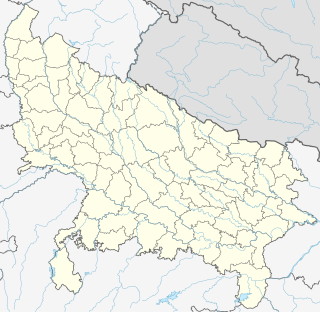
Govardhan is a key pilgrimage centre in India and a municipal town; a nagar panchayat; seat of a MLA Member of Legislative Assembly of Uttar Pradesh; a Tehsil, in Mathura district in the India in state of Uttar Pradesh. About 23 kilometres from Mathura, the town is on the road link between Mathura and Deeg.

Mathura district situated along the banks of the river Yamuna is a district of Uttar Pradesh state of north-central India. The historic city of Mathura is the district headquarters. Mathura district is home to many important sites associated with Krishna, who was born in Mathura and grew up in the nearby town of Vrindavan. Both cities are some of the most sacred sites in the Vaishnava tradition, making Mathura district is an important Hindu pilgrimage centre.

Sanatana Goswami was a principal follower of Chaitanya Mahaprabhu. Sanatana wrote a number of important works in the bhakti tradition of Gaudiya Vaishnavism and was the seniormost of the influential Six Goswamis of Vrindavan, among whom was his brother Rupa Goswami.
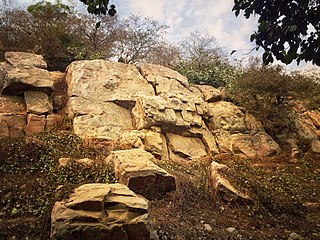
Govardhan Hill, also called Mount Govardhana and Giriraj, is a sacred Hindu site in the Mathura district of Uttar Pradesh, India on an 8 km long hill located in the area of Govardhan and Radha Kund, which is about 21 kilometres (13 mi) from Vrindavan. It is the sacred centre of Braj and is identified as a natural form of Krishna.
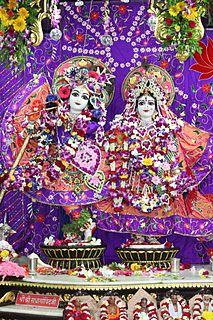
Radha-Krishna are collectively known within Hinduism as the combined forms of feminine as well as the masculine realities of God. Krishna and Radha are the primeval forms of God and his pleasure potency, respectively, in several Vaishnavite schools of thought.

Gopala Bhatta Goswami (1503–1578) is one of the foremost disciples of the Vaishnava saint, Chaitanya Mahaprabhu, and a leading historical figure in the Gaudiya Vaishnava school of Hinduism. He was part of a group of Vaishnava devotees known collectively as the Six Goswamis of Vrindavan, who were influential in establishing the philosophical basis of the Gaudiya tradition in formalised writings.

The Govardhana Shila is a rock from the Govardhan Hill in Braj,Uttar Pradesh,India. Govardhan Hill holds a unique position in Hindu scriptures related to Krishna, the land called Vrij where He was born. Known as Govardhan or Giriraj and being the sacred center of Braj, it is identified as a natural form of Krishna. Indian art overwhelmingly prefers the iconic image, but some aniconism does occur in folk worship, early Buddhism, Shiva's Banalinga, and Vishnu's Shaligrama). They have solar significance, and their use in worship predates the Hindu period in India. The stone is usually brown in color.
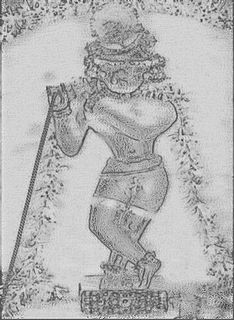
Radha Ramana is a famous image of Radha Krishna worshiped in Hinduism. There is a famous temple of this deity in Vrindavana, Uttar Pradesh, India.

Bankey Bihari Temple is a Hindu temple of the Radha-vallabha tradition dedicated to Krishna, in the holy city of Vrindavan in the Mathura district of Uttar Pradesh, India. It was constructed in 1864. Situated near Shri Radha Vallabha Temple, Bankey Bihari was originally worshipped at Nidhivan, Vrindavan.

Sri Sri Krishna Balaram Mandir, also called ISKCON Vrindavan, is one of the major ISKCON temples in the world. It is a Gaudiya Vaishnava temple located in the city of Vrindavan, Mathura district, in the Indian state of Uttar Pradesh. The temple is dedicated to the Hindu gods Krishna and Balarama. The other deities of temple are Radha Krishna and Gauranga Nityananda.
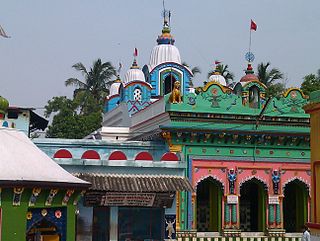
Khirachora Gopinatha Temple is in Remuna, Odisha, India. The name "Remuna" is from the word "Ramaniya" which means very good-looking. "Khirachora" in Odia means Stealer of Milk and Gopinatha means the Divine Consort of Gopis. The reference is to child Krishna's love for milk and milk products.

Sri Radha Raman Mandir or Sri Radha Raman Temple, is an early modern period Hindu temple in Vrindavan, Uttar Pradesh, India, dedicated to Lord Krishna as Radha Ramana. The temple was constructed at the request of Gopala Bhatta Goswami in 1542 AD. This temple is among the 7 temples of Thakur of Vrindavan including Shri Radha Vallabh Temple, Shri Govind Dev ji and four others. The temple is exquisitely crafted and one of the most revered temples in Vrindavan, especially by the followers of Gaudiya Vaishnavism. It houses the original shaligram deity of Krishna alongside Radharani.
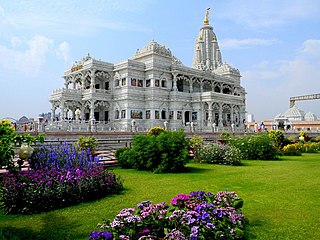
Prem Mandir is a Hindu temple in Vrindavan, Mathura, Uttar Pradesh, India. It is maintained by Jagadguru Kripalu Parishat, an international non-profit, educational, spiritual, charitable trust. The complex is on a 55-acre site on the outskirts of Vrindavan. It is dedicated to Radha Krishna and Sita Ram. Radha Krishna are on the first level and Sita Ram are on the second level. The temple structure was established by the fifth Jagadguru, Kripalu Maharaj. Figures of Shri Krishna and his followers depicting important events surrounding the Lord's existence cover the main temple.
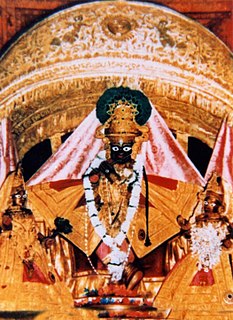
Madan Mohan Temple is a Hindu temple situated at Karauli, in the Indian state of Rajasthan. The temple is located on the banks of the Bhadravati River, a tributary of the Banas River in the hills of Aravali. The temple is dedicated to Madan Mohan form of Krishna. In the central altar, Krishna is flanked with the icons of his consort Radha and Lalita on either side.

Kusum Sarovar is a sacred water reservoir with a historic sand monument in its backdrop. It is situated on the holy Govardhan Hill between Manasi Ganga and Radha Kund in Mathura district of Uttar Pradesh, India. Kusum Sarovar is considered one of the sacred spots that witnessed the pastimes of Hindu deities Radha and Krishna. It is also the place of Jat ruler Maharaja Suraj Mal's memorial chhatri. Kusum Sarovar has Narada Kund, where Bhakti Sutra verses were written by Narada and the Shri Radha Vana Bihari Temple in the vicinity.
Gopal or Gauda is an Indian caste, which is a synonym of the Ahir (Yadav) caste from Odisha State in East India. Their traditional occupation is dairy farming, cattle-herding, cultivation and palanquin bearing. As per census of india, numerically they are the second largest population in Odisha also third in Cuttack district and comprise more than 16% of population.

Shri Radha Madan Mohan Temple, is a Hindu temple situated in Vrindavan of Indian state of Uttar Pradesh. It is one of the oldest and highly revered temple of Vrindavan. The presiding deity of the temple is Lord Madan Mohan, another name of Hindu god Krishna who is present in the central altar of the temple with his consort Radha and Lalita gopi on either sides of him.

Shri Radha Damodar Temple is a temple dedicated to Hindu deities Radha and Krishna. The temple is situated in Vrindavan of Indian state Uttar Pradesh. In the temple, Krishna is worshiped in the form of Damodar with his consort Radha. It is one of the main seven Goswami temples of Vrindavan and was established by Madhav Gaudiya Sampradaya. The deities of the temple were carved by Chaitanya Mahaprabhu's disciple Rupa Goswami and was later given to Jiva Goswami for worship.




















